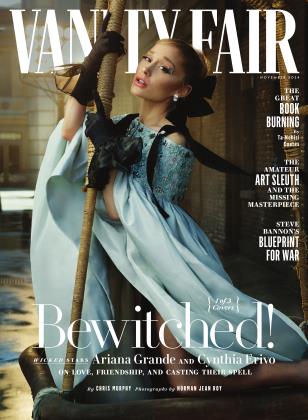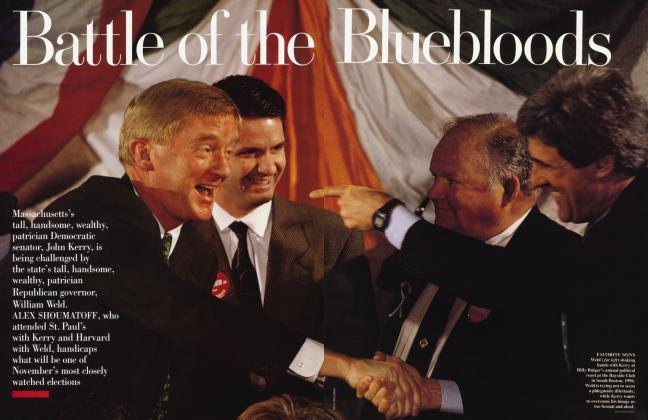Sign In to Your Account
Subscribers have complete access to the archive.
Sign In Not a Subscriber?Join NowTo mark artistic director Nicolas Ghesquière's first decade at Louis Vuitton, VF explores the house archive, with a little help from the Haim sisters
NOVEMBER 2024 KEZIAH WEIRTo mark artistic director Nicolas Ghesquière's first decade at Louis Vuitton, VF explores the house archive, with a little help from the Haim sisters
NOVEMBER 2024 KEZIAH WEIRON THE OUTSKIRTS of Paris, in an undisclosed location, sits a building that puts the most opulent closet to shame. Inside, it houses some 50,000 Louis Vuitton archival items, plus another 200,000 pieces of documents and ephemera. There are hand-beaded gowns; the lace angel wings worn by models in Virgil Abloh's posthumous fall-winter 2022 show; sunglasses labeled like insect specimens; stacks of stilettos and sneakers; 19th-century luggage designed and produced by the brand's eponymous founder, bearing the soft patina of travel and time.
Not many people enter the storage facility, and those who do often suit up like surgeons. Much of the vast collection comprises organic materials—wood, leather goods, textiles, ivory, graphic arts—so the sensitive archives are kept a cool 18 to 20 degrees Celsius, with 55 percent humidity. Aurélie Samuel, Vuitton's art, culture, and patrimony director, says that the archives serve, for the designers—currently Nicolas Ghesquière and Pharrell Williams—as "a daily source of inspiration."
There is perhaps no designer more entranced by the boggy quagmire of time than Ghesquière, who has, over his decade-plus tenure at the helm of womenswear, produced an oeuvre that constantly doubles back on itself to emerge anew, plumbing not only his own past creative efforts but the depths of Vuitton's history to work and rework concepts of self-presentation. At a moment when many major fashion houses have been undergoing changes to their creative direction—Gucci, Valentino, Chanel, Chloé, Alexander McQueen, and Givenchy, to name just a few—Ghesquière's lengthy term is all the more significant.
He arrived at Vuitton labeled a futurist, "but, you know, the future is now for me," he told Ingrid Sischy in a 2014 interview for this magazine, his first after he was announced for the role. Six years later, when I spoke to him for a mid-pandemic profile, he told me that he had become increasingly interested in history—no surprise, maybe, when at Vuitton he's so steeped in it. "My inspiration has been extended," he said, "because I'm okay to explore past, present, and future."
ESTE, DANIELLE, AND Alana Haim—the trio of 30-something sisters who are the rock band Haim, known for their intimate, ebullient love songs and music videos often directed by Paul Thomas Anderson in which they stride through the streets of Los Angeles—have been following Ghesquière's trajectory since they were teens in the Valley, rifling through magazines and tearing out Balenciaga ads; they released their first album a little more than a month before Ghesquière joined Vuitton. On a four-way video call, the sisters beaming in from their respective sun-soaked LA homes, Este calls Ghesquière "an oracle." Danielle describes his aesthetic as "lived-in, but structured and cool." When I mention that the descriptor isn't a bad fit for Haim's folky, exuberantly danceable sound, she continues, "We've always just been such fans—with clothing, with music—of taking so much inspiration from the past but hopefully making something that looks new again."
While preparing for their long-awaited One More Haim Tour for their album Women in Music Pt. Ill and in the market for an outfit—"normally on our tours we would just wear what was in our suitcases, but with this one we really wanted a uniform," Alana says—they fell in love with a pair of black leather pants from Vuitton's fall-winter 2022 women's collection, buttery and buckled with a high-waist silhouette. "There's nothing short of high kicks happening onstage," says Este. "And I think the big question was, can we do these high kicks in these leather pants? And the answer is yes."
"We actually found out later that we are the only ones that have the pants," Alana says. After the runway sample, Louis Vuitton produced only three pairs to the sisters' measurements. They topped them with black bralettes (also by Vuitton) and performed, they say, more than 60 shows in them, from Las Vegas to London—where they were joined by their good pal Taylor Swift, plunderer of past lives and layer of Easter eggs, for a mash-up of their song "Gasoline" with her "Love Story." She, too, donned the leather pants. "We have the three, and there's one in existence that she wore," Alana says. The sisters still own their pairs. The fourth is back in the Vuitton archive.
ALL MAJOR FASHION houses catalog their pasts, amassing a repository of brand codes and bygone collections. But for Vuitton, historically a trunk maker that only expanded into fashion in 1997, the archive is of particular relevance—it is a fashion brand that emerged from the beautiful rubble of its history.
In the mid 1830s it took the teenage Louis Vuitton two years and nearly 300 miles on foot to travel from his childhood home in Anchay, France, to Paris; there he apprenticed with a master box maker, began working for the empress, and in 1854 created the company that would bear his name for many years to come. The brand's rise coincided with that of the 20th-century travel boom. "People wanted to discover the world to learn from the other, from the outside country, from the foreigners," the archivist Samuel says. "So they began to think about great expeditions." Vuitton created luggage to accompany these travels, but the family were self-mythologizers and collectors too. Louis's son Georges created the iconic linked LV monogram, and his son, Gaston-Louis, gravitated toward antique trunks and objets related to travel.
Many fashion houses began to seriously consider the preservation of their archives in the 1980s, when the rise of fast fashion and industrialized techniques created a looming fear of loss, "it was at this moment that everybody has discovered that the know-how, the savoir faire, is important to preserve because it has begun to disappear," Samuel says. With Gaston-Louis, the Vuitton archive had a significant head start. And already, the past had long served as inspiration. In the 1900s Louis Vuitton began to produce flaconniers, small cases with structured compartments designed to hold perfume bottles—in the 1920s the house released its first scents. "The first idea was to pack perfume," says Samuel, "and then we made perfume."
In this year's fall-winter collection, marking 10 years designing for the brand, Ghesquière unleashed a whirlwind of the time-warped and revisited, not only rifting on motifs from his own past collections but actually printing images of historic trunks— including a 1924 automobile trunk used by Citroen—onto silk and cotton to create sculptural trompe l'oeil dresses, and on the modern silhouettes of new handbags. In his very first Vuitton collection, Ghesquière shrunk archival trunks, including a custom one made for the 19th-century banker and philanthropist Albert Kahn, into adorably tiny boxy purses: the iconic Petite Malle that remains one of Vuitton's best-known bags.
Besides its recognizable shape, the classic Petite Malle is distinguished by three stylized X's that appear on its corner, Kahn's personalization for his own trunks. Here, the snake again eats its tail, because back in 1912, Kahn embarked on an impossible venture of his own: He wished to document the entire world— "a kind of photographic inventory of the surface of the globe, occupied and organized by man, such as it presents itself at the beginning of the 20th century "—in the utopian hope that knowledge would promote a better understanding between cultures. He dubbed the 19-year project Les Archives de la Planète.
Dipping into his deep coffers, Kahn deployed nearly 15 photographers, making use of the Lumière brothers' new techniques in color imagery to produce a mind-bending 72,000 autochromes, a process requiring beakers of chemicals and fragile glass plates—prime cargo for Vuitton's packing prowess. The project came to an end in the wake of the 1929 Wall Street crash, but thanks in part to the protective casings of Vuitton luggage, the fruits of his labor live on in Le Musée Departemental AlbertKahn and its online archive: A rug maker works a loom in Algiers, soldiers await warfare at Le Hamel, a woman splits a betel leaf in Hanoi, horse-drawn carriages pause outside the New York Public Library.
There is a wistfulness to any project that seeks to fight the losing battle against time: objects stripped of context, images of vanished moments. (Vuitton is only too aware of the precarity of holding onto the past; their master perfumer, Jacques Cavallier-Belletrud, has described a 1950s fire that destroyed records of those first perfume formulations—scent memories going up in smoke.) As Jacques Derrida wrote, there would be no desire to archive without life's "radical finitude," the inevitability of loss.
"Never forget that what becomes timeless was once truly new," Ghesquière wrote Sischy 10 years ago. Or, as Samuel puts it, "When Louis Vuitton created the first trunk—or the monogram, for Georges—it was contemporary, and today it's heritage. Today's creation is tomorrow's heritage."
There is a tender democratization that occurs, too, when a simple Pyrex beaker is treated with as much care as a trio of Yayoi Kusama polka-dot bikini bottoms, or the brittle pages of a ledger, begun in 1910, marking Kahn's purchases: a few small trunks, a holdall bag, two flaconniers, and several cashmere throws and scarves. They have all, for now, been saved from oblivion.
FOR DETAILS, GO TO VF.COM/CREDITS.
 View Full Issue
View Full Issue


















Subscribers have complete access to the archive.
Sign In Not a Subscriber?Join Now